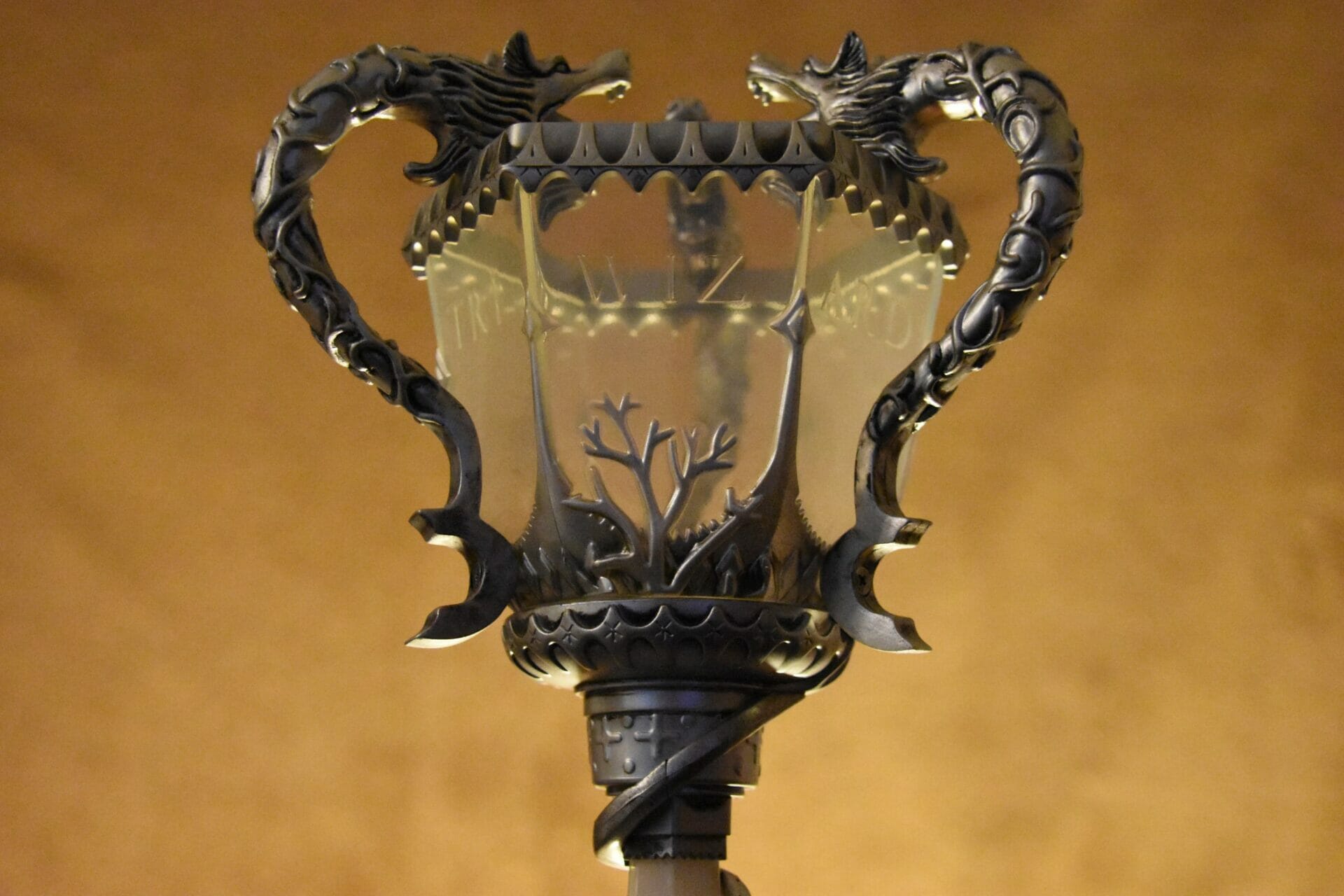
Harry Potter and the Goblet of Fire | A new beginning
Author
Format
Length
There are some historical sports competitions in the world that, despite bringing a rivalry between competitors, manage to unify the whole community. Muggles have World Cup and Olympic Games; while wizards have the Quidditch World Cup and the Triwizard Tournament. In Harry Potter and the Goblet of Fire, Harry is spectator of the first one and competitor in the second. Both events are much more adventurous than he expects, and both bring a dark, unexpected turning point.
The fourth episode of Joanne K. Rowling‘s saga was published in 2000 by Bloomsbury in the UK, and by Scholastic in USA. It was the first book of the saga released in two countries at the same time. Jim Kay realized an illustrated version in 2019, and Mike Newell directed a homonymous movie in 2005.
Extending the edges of wizarding world
Two bits of news await the students at Hogwarts. There is a new Defense Against Dark Arts professor, Alastor Moody, called ‘Mad-Eye’ due to his magic, disturbing eye. And the school will host the Triwizard Tournament, a competition between magic schools: Hogwarts, the French Beauxbatons Academy, and the Northern European Durmstrang Institute. The Goblet of Fire, an enchanted item within which a blue flame burns, chooses a delegate for each school and a series of dangerous challenges determine the winner. Fleur Delacour from Beauxbatons, Viktor Krum from Durmstrang and Cedric Diggory from Hogwarts are the competitors in the Triwizard Cup. But to everyone’s surprise, the name Harry Potter appears from the Goblet of Fire, making him the fourth champion.
The Triwizard Tournament brings glory to its winner, but at great cost. Challenges endanger competitors’ lives, but above all, they risk betraying their own ideals to reach glory. Trials require deep knowledge of magic subjects and a brilliant mind. Competitors receive a clue to decode before each dare, testing their ability to find creative solutions. Harry knows he is not ready: only his friends’ help prevents him from failure. He never finds a solution by himself: Hermione tips some spells, Dobby grabs a special seaweed, and Cedric recommends a bath. But all of them received a tip from Moody, who seems to have a special connection to Harry.
This importance of puzzles recalls many stories whose protagonists had to solve riddles to triumph, such as the sphinx, the mythological creature that Oedipus in Sophocles‘ tragedy had to defeat. While Calaf in Giacomo Puccini‘s Turandot meets the princess’s challenges, in William Shakespeare‘s Merchant of Venice Portia’s father creates three riddles to understand who is worthy of marriage to his daughter. In more recent times, Steven Spielberg‘s protagonist in Ready Player One has to solve an impossible puzzle.
Dark dreams and memories
Before the beginning of school, Harry goes with Hermione and the whole Weasley family to the Quidditch World Cup. But at the end of the game, something strange happens: something that younger wizards can’t remember, since it never emerged in the past thirteen years. The Dark Mark, the emblem announcing the presence of Death Eaters, appears in the sky, spreading terror.
After its apparition, Harry has strange dreams about Voldemort, or rather visions about what he is doing. He starts asking details about his past and what caused his parents’ death. Dumbledore decides it is time for Harry to know something more about Voldemort’s ascent to power. So, he shares his memory with the boy through the Pensieve, a magic basin used to store and bring back to life memories. One of them shows Harry someone he already knows: Barty Crouch Sr., head of the Department of Magical Law Enforcement. What Harry didn’t know was that his son was a Death Heater, and Crouch Sr. sent him to Azkaban.
The use of Pensieve sheds the light on the relationship wizards have with their past and memories. They know remembrance has a great importance, but it can also be unintentionally manipulated. The possibility to extract memories from ones own mind allows to shelve them for a while. On the other hand, the Pensieve gives the possibility of sharing them with other people, conveying the past without filters.
After confronting dragons, mermaids and enchanted labyrinth, Harry has the greatest challenge to face. His dreams were actual premonitions: Lord Voldemort is back. Through flesh, blood and bone sacrificed to him, he obtains a new body to rise again in the wizarding world.
Developing morality thought magic
As Christians have capital sins, so magicians have Unforgivable Curses: the Killing Curse, Cruciatus Curse and Imperius Curse. Bringing death, unbearable pain, or obliging people to do whatever they are told, they are dark wizards’ weapons. Professor Moody shows their effects to students using a spider as a test animal. His method hurts sensitive students, including Hermione, and pushes them into discussing about what happened. Their debate deals with themes that go beyond magic: they wonder if it is right to teach something ethically wrong, and if it is necessary to know the evil to defend oneself against it.
The Triwizard Tournament attracts the attention of journalists. Between them there is Rita Skeeter, who more than reporting, looks for rumors and fake news for its own sake. By rewriting events the way she wants, she often destroys people’s life. So it happened to Frank Bryce, the Riddle family’s gardener, whose existence was ruined after the accusation of homicide of his employers. Although he was declared innocent, he never had a place in society anymore. Skeeter’s bad behavior and unfair methods make young wizards discover they can’t believe in everything in newspapers.
Growing up in both world
In Harry Potter and the Goblet of Fire, young wizards are crossing a time of creation of their own personality. They have to decide to whom be loyal, what is evil and what is good, what they can believe in and what not. As teenagers, they have to face the challenges of becoming adult. They start caring about what they wear, and experiment with the first loves. After years of cohabitation with his terrible cousin, Harry discovers at his own expense bullies exist at Hogwarts too. Nobody believes he didn’t meant to participate in the Triwizard Cup, so the whole school roots for Cedric.
Students also start developing interest in politic and ideology. When Hermione discovers many slave house-elves work at Hogwarts, she founds the S.P.E.W. (Society for the Promotion of Elfish Welfare). Coming from a Muggle family, she knows similar battles were already fought in her world, since slavery was abolished for a long time. She can’t stand inequality for any living being.
If you want to know what a man’s like, take a good look at how he treats his inferiors, not his equals.
Harry Potter and the Goblet of Fire assumes darker shades, starting from settings: the cold light emanating by the Goblet of Fire, the dark labyrinth, and the graveyard where Voldemort returns to life. Fantasy adventures mix with a more mature language, hinting at fictional characters and readers growing up together. Also the novel faces darker issues: the comeback of Voldemort, along with the discover of Unforgivable Curses, puts in the spotlight deep themes, such as death, homicide and sacrifice (voluntary or not).
The fourth book poses as midpoint in the saga, even from the visual pain of view, marking the point of no return. Voldemort’s comeback signs a new beginning for the magic world, which has to prepare for dark times.
The time should come when you have to make a choice between what is right and what is easy.
Tag
Buy a ☕ for Hypercritic









